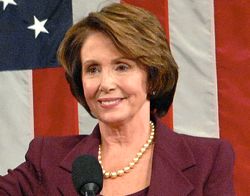Key events in the past and future of Obamacare.
Fall 2008: Presidential candidate Barack Obama says, “On health care reform, the American people are too often offered two extremes — government-run health care with higher taxes or letting the insurance companies operate without rules. … I believe both of these extremes are wrong.” Obama wins the presidency a week later.
March 2009: President Obama convenes a “health summit” with doctors, insurers, drug companies, consumers advocates and lawmakers. “The status quo is the one option that is not on the table,” the new president says. He appoints Kansas Gov. Kathleen Sebelius, who has a history of clashes with the insurance industry, to run the federal Health and Human Services agency. She also heads the White House Office for Health Reform.
 July 2009: House Democrats unveil their 1,000-page plan for overhauling the health care system. House Speaker Nancy Pelosi (pictured), an ally of Obama’s, says: “When I take this bill to the floor, it will win. This will happen.” House committees begin crunching the details and voting on provisions.
July 2009: House Democrats unveil their 1,000-page plan for overhauling the health care system. House Speaker Nancy Pelosi (pictured), an ally of Obama’s, says: “When I take this bill to the floor, it will win. This will happen.” House committees begin crunching the details and voting on provisions.
August 2009: Lawmakers go home to find walls of worry erected over “Obamacare.” One lawmaker says citizens are “shell-shocked” over the many changes in the first eight months of Obama’s administration.
Nov. 7, 2009: The House approves its version of health care reform in a 220-215 vote. One Republican votes for the bill. Passage was far from certain — a last-minute compromise limiting federal funding for abortion services cleared the way.
Dec. 24, 2009: The Senate approves its version of the health care overhaul in a 60-39 party-line vote. Democrats have to break a GOP filibuster. The bill’s passage confirms majority agreement in both chambers of Congress.
January 2010: Obama, in his first State of the Union address, says the health overhaul will “protect every American from the worst practices of the insurance industry.” … In a major upset, Massachusetts state Sen. Scott Brown, a Republican, wins the special election to finish the remaining term of U.S. Sen. Ted Kennedy. It gives the GOP a key vote and is seen as a major rebuff to Obama. Brown works actively against Obamacare. Meanwhile, the GOP-controlled House votes to repeal the Affordable Care Act, but the effort fails in the Senate.
February 2010: Anthem Blue Cross of California informs many members they’ll be paying a 39 percent increase in premiums. The move, under investigation by the White House and in Congress, galvanizes Democrats on the health care issue. Obama calls a bipartisan health care meeting for leaders of both parties on Feb. 25. He later says “the Republican and Democratic approaches to health care have more in common than most people think.”
March 2010: President Obama and House Speaker Nancy Pelosi keep up pressure on Democrat lawmakers to ensure passage of the health care act. “We are this close to the summit of the mountain,” Obama tells staffers. A New York Times analysis calls it “the most riveting cliffhanger of the Obama presidency so far.”
March 21, 2010: The Senate’s version of the health care plan is OK’d by the House in a 219-212 vote. All Republicans voted against it. “The American people are angry,” House Republican leader John Boehner said. “This body moves forward against their will.”
 March 23, 2010: President Obama signs the Affordable Care Act into law. “We did not fear our future, we shaped it,” he says.
March 23, 2010: President Obama signs the Affordable Care Act into law. “We did not fear our future, we shaped it,” he says.
June 2010: The first major provision of the Affordable Care Act go into effect, allowing adults with existing conditions to join temporary high-risk pools that expire when the Act takes effect.
September 2010: More elements of the Affordable Care Act go into effect: No lifetime dollar limits on health care coverage; dependent children allowed to stay on parents’ insurance until age 26; no pre-existing exclusions for those under age 19; insurers barred from requiring co-payments for preventive care and vaccinations.
Sept. 30, 2010: The California Patient Protection and Affordable Care Act is signed into law by the governor. It creates the California Health Benefit Exchange, which goes by the name Covered California. The legislation was AB 1602. Read the California Act (PDF)
January 2011: A Florida judge rules that elements of the Affordable Care Act are unconstitutional.
September 2011: Health insurers are required to go public with rates increases of 10 percent or more.
Nov. 14, 2011: The U.S. Supreme Court agrees to hear arguments in the Obamacare case brought by 26 states and the National Federation of Independent Business. It argues that elements of the Affordable Care Act are unconstitutional.
June 28, 2012: The U.S. Supreme Court upholds the major provisions of the Affordable Care Act. Twenty-six states and the National Federation of Independent Business had brought suit in federal court challenging the individual mandate and the Medicaid expansion. “In the end, the Affordable Care Act survives largely unscathed,” one justice wrote. Republicans and the Tea Party pin their hopes on presidential hopeful Mitt Romney, who responds to the ruling saying: “Obamacare was bad law yesterday; it’s bad law today.” Read the ruling (PDF) — (text continues)
August 2012: The White House confirms the Act’s “contraceptive mandate” for women’s preventive services without cost sharing: HIV screening, contraception counseling, domestic violence support services.
Nov. 6, 2012: Obama re-elected, effectively ensuring the Act will survive another five years.
January 2013: Limit on pretax contributions to flex spending accounts capped at $2,500 annually.
 May 23, 2013: The California health insurance exchange unveils a preview of its plans, with key insurers including Blue Shield, Anthem, Health Net and Kaiser Permanente.
May 23, 2013: The California health insurance exchange unveils a preview of its plans, with key insurers including Blue Shield, Anthem, Health Net and Kaiser Permanente.
June 27, 2013: Gov. Jerry Brown signs into law two sweeping California health reform bills that are key to implementing the the Affordable Care Act.
July 2, 2013: The White House agrees to a one-year delay in the requirement that large businesses must provide workers with affordable health care. Reporting requirements get the blame. California officials shrug off the large-business health care delay.
Oct. 1, 2013: Health insurance exchanges are scheduled to open, writing policies that go into effect Jan. 1.
Jan. 1, 2014: The bulk of Affordable Care Act changes go into effect with the new year. The Act:
- Opens Health Benefit Exchange sales of coverage.
- Prohibits denial of coverage to adults with pre-existing conditions.
- Requires large employers to provide coverage to those who work at least 30 hours per week.
- Expansion of eligibility for the Medi-Cal program.
- Tax credits for small business that provide coverage.
- Tax credits for individuals and families with incomes up to $94,200 (for a family of four) who buy their insurance through the Health Benefit Exchange.
January 2016: Threshold for itemizing medical expenses on taxes increases from 7.5 percent to 10 percent for seniors.
 November 2016: Donald Trump is elected president. One of his major campaign promises is to “repeal and replace” the Affordable Care Act.
November 2016: Donald Trump is elected president. One of his major campaign promises is to “repeal and replace” the Affordable Care Act.
March 2017: GOP leaders pull their proposed American Health Care Act after failing to win over Republican conservatives and moderates. “Obamacare is the law of the land,” a disappointed House Speaker Paul Ryan says.
January 2018: Under the Affordable Care Act, all existing health insurance plans must cover preventative care and checkups without co-pays.
January 2020: Medicare Part D donut hole (coverage gap) phased out.
Recent Comments